Chrome is stopping some of its users from loading local resources on the browser. This resource can be an image, a PDF, or a text file. One of the main reasons for the error is misconfigured settings of the browser. In this post, we are going to talk about this and see what to do when Chrome is not allowed to load local resources.
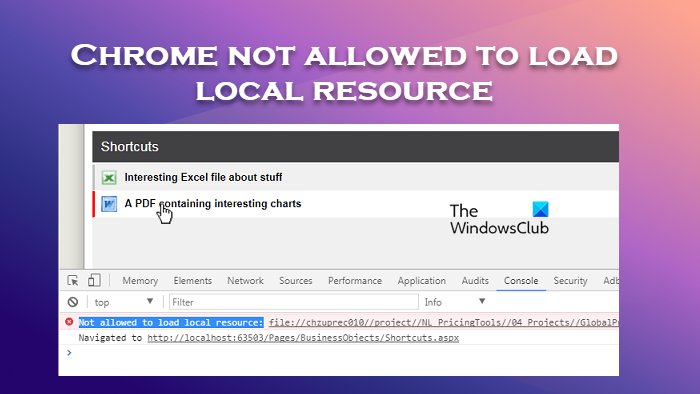
How to fix Chrome not allowed to load local resource
If Chrome is not allowed to load local resources, the first thing you should do is restart the browser. In case, the issue is a result of some temporary glitches, restarting will be enough. However, if restarting the browser is to no avail, follow the steps given below.
- Turn off the Chrome Security Settings
- Change the DNS Settings
- Clear DNS Host Cache
- Install the Web Server Extension for Chrome
- Clear Chrome’s Cache and Browsing Data
Before your bgin, hard refresh the web page by pressing CTRL+F5 and see if ir helps.
1] Turn off the Chrome Security Settings temporarily
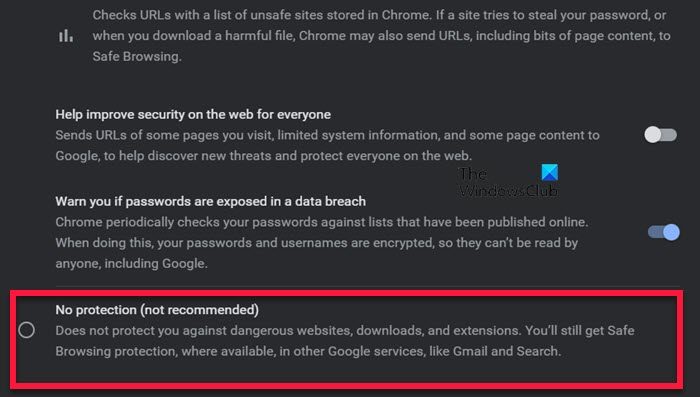
Chrome has the tendency to block and not load the image if it thinks it has some malicious elements. But there is a possibility that the algorithm that the browser uses to check for malware is at fault and your file is totally fine. In that case, we have to disable the security settings in Chrome and then load the file.
As we know that Chrome security should not be disabled, if you alter the setting, you are opening the path for the hacker. Therefore, make sure that the resource you are loading is malicious-free and after loading the file, make sure to turn the settings back on. Follow the prescribed steps to do the same.
- Open Chrome browser on your computer.
- Once it opens, in the top right corner of the Chrome window click on the three-dotted line and select Settings.
- Click on Privacy and Security from the left pane of the Settings page.
- Now, click on Security and here you should go to the No protection (not recommended) option.
- Finally, turn off the toggle for No protection.
It would be better to turn on the security after you are done loading the resources.
2] Change the DNS Settings
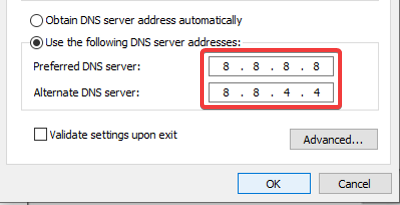
The function of the DNS (Domain Name System) is to translate the domain name to the IP address and the IP address to the domain name. Whenever users type domain names, like thewindowsclub.com, into the address bar of web browsers, the DNS finds the right IP address of that website. Once the DNS server finds the correct IP address, your required website will be accessed. If the computer is dynamically switching DNS, the Chrome browser may block it because of security concerns. So, we can use Google DNS servers to resolve the error. Here is how to do it.
- Press Windows + R key to open the Run dialog box.
- Type ncpa.cpl and press the Enter button to open Network Connections.
- Right-click on the Network adapter and select Properties.
- Here, select the Internet Protocol Version 4 (TCP/IPv4) option and select Properties.
- Select Use the following DNS server addresses option and enter the following IP address.
Preferred DNS server: 8.8.8.8
Alternate DNS server: 8.8.4.4
- Finally, click on the OK button to save the setting.
Hopefully, after configuring the Google DNS address the issue will be resolved.
3] Clear DNS Host Cache
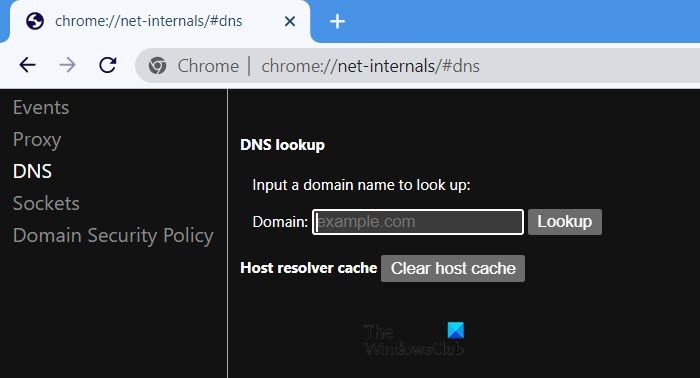
Google Chrome has a built-in DNS cache server that will help us to improve the website loading speed. If the developer of the website has changed the IP address, the cache will automatically load the previous IP address and you may face the said error. Therefore, it is a good idea to clear the host cache and this will resolve the error.
- Firstly, open the Chrome browser on your computer and enter the following string in the address bar.
chrome://net-internals/#dns
- After hitting the Enter button, you will get the Clear host cache option.
- When you click on that you have cleared the host cache file.
Now close Chrome and open it again and see if your problem is solved.
4] Install the Web Server Extension for Chrome
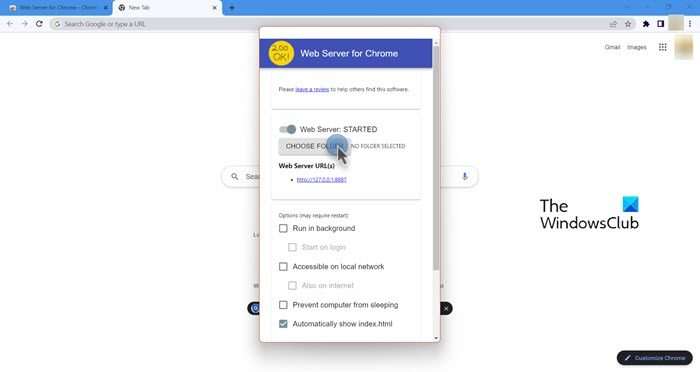
The Web Server is a Chrome extension that runs offline and it will help to serve files and webpages to the network from a local folder. So we can set up an HTTP server to resolve the said error. Follow the steps to install the extension.
- Go to chrome.google.com to load the Web Server for the Chrome extension page.
- Now, press the Add to Chrome button and it might be possible that it will ask you to sign in to Chrome to add the extension.
- Once installed, open the extension.
- Here, click the CHOOSE FOLDER button and browse your project folder.
- Finally, click the address shown under the Web server URL and run the web server.
Hopefully, this will do the job for you.
5] Clear Chrome’s Cache and Browsing Data
Last but not least, if nothing worked, our last resort is clearing Chrome’s cache and browsing data. This is done to ensure that the peculiar behavior of the browser is not caused by corrupted data. In order to do the same, follow the steps given below.
- Open Google Chrome.
- Click on the three dots and then click on Settings.
- Go to the Privacy and Security tab from the left side of the window.
- Select Clear browsing data.
- Change the Time range to All time.
- Tick Browsing history, Cookies and other side data, and Cached images and files. You can also tick other boxes if required.
- Finally, click on Clear data.
You need to wait for the browser to clear all its data and then check if the issue is resolved.
Hopefully, you will be able to resolve the issue using the solutions mentioned above.
Read: Fix Error 0x80040902 during the Google Chrome update
How do I fix Chrome not allowed to load local resources?
If Chrome is not allowed to load resources, you should start troubleshooting by restarting the browser and the computer if the former doesn’t work. In case, restarting is to no avail, follow the solutions mentioned in this post to resolve the issue.
Read: Fix ERR_CONNECTION_RESET error on Chrome browser
How do I open a local file in Chrome?
It is pretty easy to open local files in Google Chrome. In order to do the same, open a new tab in Chrome, even though it is not mandatory to open a new tab, it’s a better practice, and then Ctrl + O, now go to the location where your files are stored and finally open it.
Also read: How to open Local Files on Chrome.